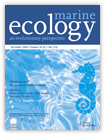Seasonality of Plankton Assemblages in a Temperate Estuary
Abstract
Abstract. Synoptic measurements of temperature, salinity, nutrients, primary productivity, chlorophyll a, and abundance and composition of phytoplankton, zooplankton, and ichthyoplank-ton were made over an annual cycle on the Peconic Bay estuary (Long Island, New York, USA).
There were pronounced seasonal fluctuations in all variables measured. During the warmer season, the plankton was dominated by nanophytoplankton (athecate microflagellates and chlorophytes, short chains of diatoms), small zooplankton (copepod nauplii, copepodites, and adults of small copepod species) and gelatinous carnivores (ctenophores and medusae). During the colder season, the plankton was dominated (in terms of primary productivity and chlorophyll a) by netplankton, larger zooplankton (adult copepods) and fish larvae. The winter bloom of apparent netplankton (> 20 μm fraction) was largely an artifact of the screening method employed, in that long chains of a diatom with small individual cell size (Skeletonema costatum) comprised 84.4–97.8% of the phytoplankton present. There was a significant negative relationship over the year between length of diatom chains and number of smaller zooplankton. For this reason, as well as initiation of the winter bloom during a period of declining levels of both light and zooplankton, inception of the bloom appeared more related to release of zooplankton grazing pressure than to illumination. Temporally offset pulses of ctenophores and other zooplankton during the warmer season suggest substantial predation by ctenophores. Apparent decimation of copepod populations by ctenophore predation in late summer and fall immediately preceeded inception of the winter diatom bloom. Larval Ammodytes americanus were the dominant ichthyoplankton, and these co-occurred in winter with increased abundances of larger adult copepods of species upon which A. americanus is known to feed. With certain modifications the patterns recorded for Peconic Bay corresponded to both of two generalized trophic pathways proposed by Greve & Parsons (1977) for temperate waters: nanoplankton → small zooplankton → gelatinous zooplankton carnivores or
netplankton → larger zooplankton → young fish.
The former pattern characterized the warmer season, and the latter the colder season. Comparison of patterns in Peconic Bay with those in some other temperate estuarine and coastal waters suggests similarity, particularly for estuaries of the northeastern United States.




